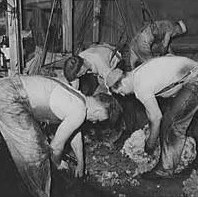What Happens To The Wool When The Sheep Are Sheared?!
Published on 5 Jul 2016 by Gwion LlwydI went to see a friend at the weekend and whilst having a cup of tea was entertained by the sheep being sheared in the ‘back garden’. It it did make me chuckle seeing a ‘mobile hairdressers’ set up in the field for the sheep and made me think about “what happens to the wool when the sheep are sheared?”…
STAGE 1 | SHEARING
 Sheep shearing is an important and social time in the farming calendar. Here in Snowdonia, the farms still join forces to help one another to shear the flocks. When it comes to the art of shearing, it is preferable to get the fleece off all off in one piece. It makes for a much easier job when sorting at the mills as different parts of the fleece are used for different products e.g. clothing, carpets, blankets etc.
Sheep shearing is an important and social time in the farming calendar. Here in Snowdonia, the farms still join forces to help one another to shear the flocks. When it comes to the art of shearing, it is preferable to get the fleece off all off in one piece. It makes for a much easier job when sorting at the mills as different parts of the fleece are used for different products e.g. clothing, carpets, blankets etc.
STAGE 2 | SCOURING
 Scouring is the the technical term for washing where the wool is put into a series of alkaline baths to remove any dirt and impurities. Lanolin which is naturally found in wool is also removed at this stage and is usually then sold on for use in products like cosmetics. Once all clean, the raw wool is left to dry.
Scouring is the the technical term for washing where the wool is put into a series of alkaline baths to remove any dirt and impurities. Lanolin which is naturally found in wool is also removed at this stage and is usually then sold on for use in products like cosmetics. Once all clean, the raw wool is left to dry.
STAGE 3 | COMBING AND CARDING
 Combing is where the wool is sorted into longer and shorter fibres.
Combing is where the wool is sorted into longer and shorter fibres.
Carding is where the wool is made into soft rolls called rovings or rolags. The wool is teased into individual fibres by being massaged in-between two sets of ‘metal teeth’.
Woollen duvets use the wool at this stage as the wool still retains the cuticles (small hooks) in it’s structure. These cuticles enable wool to regulate temperature and make woollen duvets naturally hypo allergenic – dust mites hate these hooks! Baavet, a manufacturer of woollen duvets based here in Snowdonia use wool that has been treated as little as possible so as to retain the wool’s natural properties.
STAGE 4 | SPINNING
 Spinning involves the pulling and twisting of the woollen fibres in to a continuous thread. It is the cuticles mentioned before that hook together when twisted and pulled. There are 2 types of yarn that can be created; woollen yarn (for knitwear and carpets) is made out of the longer fibres and worsted yarn (cloth for suits) is made out of the smaller fibres.
Spinning involves the pulling and twisting of the woollen fibres in to a continuous thread. It is the cuticles mentioned before that hook together when twisted and pulled. There are 2 types of yarn that can be created; woollen yarn (for knitwear and carpets) is made out of the longer fibres and worsted yarn (cloth for suits) is made out of the smaller fibres.
STAGE 5 | WEAVING
 Weaving is the process where the yarn creates the cloth / blanket etc. Set up on a loom, warp threads are the ones that are attached to the loom and run parallel to one another and the weft threads are the ones that go under and over the warp threads creating the patterns. Melin Tregwynt Mill in mid wales have a great selection of different types of woollen fabrics for blankets, clothes and upholstery.
Weaving is the process where the yarn creates the cloth / blanket etc. Set up on a loom, warp threads are the ones that are attached to the loom and run parallel to one another and the weft threads are the ones that go under and over the warp threads creating the patterns. Melin Tregwynt Mill in mid wales have a great selection of different types of woollen fabrics for blankets, clothes and upholstery.
If you want to see some Welsh blankets being woven, Trewfrew Mill, based near Conwy allow visitor to watch the process being done. Along with a museum showing traditional carding techniques and spinning demonstrations, it makes for a very interesting day out.



